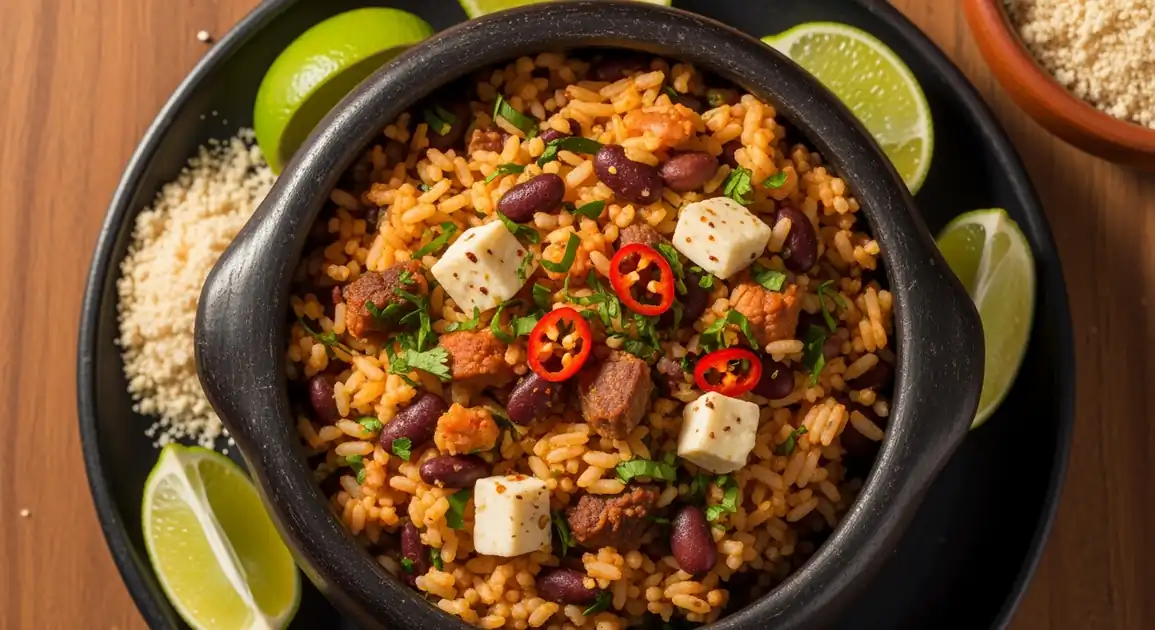Baião de Dois
Baião de Dois

Description
In Rio de Janeiro, Baião de Dois represents the significant northeastern cultural influence on the city. While not originally carioca (Rio native) cuisine, the dish has been embraced and adapted in this cosmopolitan setting, where you'll find both traditional versions in northeastern cultural enclaves and modern interpretations in upscale restaurants.
Dietary Information
Serving information
Serving style
In Rio, often served in individual portions in clay pots or cast iron pans. Modern restaurants may present it with contemporary plating. Typically accompanied by farofa, vinaigrette salsa, and sometimes collard greens (couve).
Quick facts
Traditional restaurants: 11 AM - 3 PM and 6 PM - 10 PM. Feira de São Cristóvão: Friday 10 AM - 7 PM, Saturday 10 AM - 10 PM, Sunday 10 AM - 7 PM. Upscale venues may serve dinner until midnight.
Safety Tips
What to Look For
-
Freshly prepared dish served steaming hot
Properly heated food minimizes bacterial risk. The dish should be served steaming and the cheese should be fully melted.
-
Clean restaurant or food stall with proper refrigeration
Since Baião de Dois contains perishable ingredients like cheese and sometimes meat, proper storage is essential.
-
Visible, identifiable ingredients
You should be able to distinguish individual rice grains, beans, and pieces of cheese or meat. Avoid versions where everything is mushed together.
-
Herbs that look fresh and green
Wilted or discolored herbs may indicate the dish was prepared long ago or stored improperly.
What to avoid
-
Refrigerated and reheated versions
Rice dishes can develop bacteria when improperly stored and reheated. Prefer freshly made Baião de Dois.
-
Excessively dry or crusty appearance
This suggests the dish has been sitting under heat lamps or warming equipment for too long.
-
Sour smell or off taste
Can indicate spoilage of dairy or meat components. Trust your senses.
-
Room temperature serving
The dish should be served hot, not lukewarm, especially because of the cheese and potential meat content.
Price information
Price range
Budget tips
- The most authentic and affordable versions are found at Feira de São Cristóvão, the northeastern cultural center.
- Many per-kilo restaurants (restaurantes por quilo) offer Baião de Dois at lower prices than à la carte establishments.
- Lunch specials (pratos executivos) typically cost 30-45 BRL and include sides.
Value indicators
- Proper portion size (usually serves 1-2 people generously).
- Quality of the queijo coalho - should be melty but still visible in the dish.
- If it includes carne de sol, the meat should be tender, not tough or overly salty.
- Accompaniments like farofa, vinaigrette, and fresh lime should be included.
Where to Find This Dish
Feira de São Cristóvão
This northeastern cultural center houses numerous authentic vendors specializing in northeastern cuisine.
Centro Luiz Gonzaga de Tradições Nordestinas
Saturday Afternoon, Sunday Daytime
Centro
Several traditional northeastern restaurants are located in Rio's downtown area.
Around Praça Tiradentes, Near Campo de Santana
Weekday Lunch (11 AM - 3 PM)
Botafogo and Flamengo
These neighborhoods feature both traditional and modern restaurants serving northeastern cuisine.
Rua Voluntários da Pátria, Rua Marquês de Abrantes
Dinner (7 PM - 10 PM)
Copacabana and Ipanema
Tourist areas with both authentic northeastern restaurants and upscale Brazilian fusion restaurants.
Side streets off Avenida Atlântica, Rua Barão da Torre
Dinner (7 PM - 11 PM)
Vendor Tips
- At Feira de São Cristóvão, look for stalls with northeastern owners who proudly display their home state flags.
- Restaurants that also serve good "buchada" and "sarapatel" (other northeastern specialties) usually make excellent Baião de Dois.
- Ask if they use authentic queijo coalho from the Northeast rather than generic substitutes.
How to Order
Regional Variations
-
Upscale Baião
(Baião Gourmet)
Trendy Rio restaurants offer refined versions with premium ingredients like organic rice, heirloom beans, artisanal cheese, and prime cuts of meat.
-
Seafood Fusion
(Baião com Frutos do Mar)
A uniquely carioca adaptation incorporating Rio's seafood tradition, featuring shrimp, squid, or fish instead of traditional carne de sol.
-
Health-Conscious Version
(Baião Fitness)
Modified versions catering to Rio's health-conscious culture, using brown rice, less oil, and reduced-fat cheese options.
-
Street Food Adaptation
(Baião de Copo)
Some vendors at Feira de São Cristóvão serve a portable version in cups or cones for walking around the market.
Cultural context
History
Baião de Dois originated in Brazil's Northeast, particularly in Ceará and Pernambuco states, as a practical solution to limited resources among working-class families. Its name refers to "baião," a popular northeastern music rhythm, suggesting the harmonious "dance" of rice and beans cooking together. Historically, it was a way to transform basic staples into a complete protein-rich meal, using ingredients available to rural communities. The dish gained national popularity as northeastern migrants brought their culinary traditions to major cities like Rio de Janeiro, where it's now celebrated as comfort food and a symbol of regional Brazilian heritage.
Local significance
In Rio, Baião de Dois represents the northeastern migrant community's cultural contribution to the city. It bridges regional cuisines and symbolizes Brazil's culinary diversity.
Eating customs
- In Rio, often enjoyed with a caipirinha or cold beer on the side.
- Locals might mix in additional hot sauce (especially malagueta pepper sauce).
- Sometimes eaten as a complete meal rather than with multiple sides as in the Northeast.